How to sex tilapia
Determining the gender of a tilapia is one of those topics that leaves most people scratching their heads and wondering what they've missed. If I had to guess, I'd attribute the confusion to all of the inaccurate videos left to "rot" for eternity on YouTube, and all the lazy cut-and-paste web "authors" who grab incorrect information from other sites, then put their own spin on it. There are a few web sites that get it right, but even then only basic tidbits of information is given without explaining the full range of possibilities. In other instances, the information is presented in a technical format that assumes too much peripheral knowledge on the part of the reader.
Unlike our tilapia farming guide, which is written for people with no prior tilapia farming education, I'm going to assume that you have already been exposed to lots of useless and inaccurate information. To help you purge these inaccuracies from your knowledge base, I am going to go outside of my usual bounds and push back against a few common misconceptions that currently dominate the Internet search engines.
Before we start sexing tilapia
I have avoided writing this page for a long time. Not because it's some big trade secret, or that I'm worried that people will sex their own tilapia and create competition for Lakeway Tilapia. I already know that a couple of tilapia re-sellers are going to send me hate emails over this page, and I don't even care about them either. The reason that I have avoided writing this page is because people are going to argue with me. Not other tilapia hatcheries, but everyday people who have been exposed to so much bad information that they will contact we with "what about this" or "I heard that" or "here's how I do it". So before I even begin to explain how to sex tilapia, there are a few things to which you must agree.
Educators read this first
I am very honored by the fact that Lakeway Tilapia is used as a teaching aid in classrooms all over America. As I add pages to this website, I do my best to live up to the standards that teachers have come to expect. The subject of sexing tilapia is easier to explain by referencing reproductive organs in more familiar terms and using more familiar life forms, including humans. If you are teaching children under the age of 18, please review how the information on this page is presented, and determine for yourself if the material is appropriate for your school district. If you encounter anything that causes concern, please don't hesitate to email me.
Breeding tilapia
If you are attempting to determine the gender of a tilapia for the purposes of breeding, please realize that there is much more to setting up a breeding colony than simply identifying random males and females. To be successful, your tilapia must exhibit breeding behavior.
For males, this means very aggressive behavior towards the females, almost to the point of killing them. For females, this means very subordinate behavior, hiding in tubes, and avoiding the male when she's not ready to spawn. Alpha females that prevent spawning for the entire colony, or males that school with the girls are examples of traits to be avoided. There are even positive traits that may prove to be a bonus to reproduction in some tilapia species. Identifying tilapia gender is only the first step in establishing a successful breeding program.
Read and understand
To those who say that a picture is worth a thousand words, I say that a picture, like all art, is open to a thousand interpretations. Those of you who have learned from my guides, have done so because I've taken the time to write those thousands of words. There are dozens of misleading videos and poorly labeled pictures on the Internet. One picture in particular is used on two different web sites with different tilapia identified as the female on each. Even the picture that is correctly labeled, leaves the viewer with the impression that all tilapia oviducts look the same. Which they do not. So before you send me an email asking for pictures, take a second to read my words again. If something isn't clear, please email me and I'll update this page with even more words.
No sexing "granny tilapia"
There is a video on the Internet in which the presenter nets a mature tilapia, flips her over, rubs food coloring on her genitalia, and shows her oviduct. He actually starts out by saying that he's no expert, provides erroneous temperature and environment information, then makes incorrect generalized statements about the shape of the genital papilla. He concludes his presentation by reiterating the fact that he is no expert. I am always annoyed by people who attempt to teach-by-cop-out stating "here's how we do it" and <in case you don't get the same results> "we're no experts"
Tilapia start breeding at four inches long, or about 60 days old. This is when their reproductive activity is at its most frequent. By the time that they have grown to roughly eight inches long, they have all but stopped reproducing in small systems. This is largely due to territorial requirements and tank space. Breeding large tilapia requires cage or pen techniques that are no longer economically viable. For this reason, you will need to learn how to sex tilapia that are under four inches long with water-tight oviducts. You simply cannot do this with food coloring and the un-aided eye.
No Emails about sexing tilapia
Under no circumstances will you email me with your alternate methods or ideas. Do not ask me if there is another way to determine tilapia gender, such as color, or stripes, or spots. There isn't. We both agree that I will delete your email without answering it and that you will not be offended.
sexing tilapia vs. determining gender
I really don't like using the phrase "how to sex tilapia". Aside of sounding creepy, it doesn't tell non-fish-people what you are doing. I'd much rather use "how to determine the gender of tilapia". Unfortunately, if I want this page to be found on the Internet, I have to use the first one. That said, when you communicate with me, and hopefully in future communications with others, you will change your description to the latter.
Common misconceptions
Here are a few things that you may have read on the Internet about sexing tilapia that would best be forgotten.
A spot on the dorsal fin
Some people believe that a spot on the dorsal fin of a fingerling indicates that the fingerling will be a male. Other's believe that the spot indicates the species. It's just a spot people. All tilapia fingerlings get them, they are meaningless.
Genital papilla shape
It has been said that the shape of the genital papilla can be used to determine the gender of a tilapia. This is utter hogwash. Tilapia genitals come in all shapes and sizes, just like all living creatures. In tilapia, the genital papilla can be long and slender, big and round, go from fat to pointy, or from pointy to fat. Some hang down and some appear almost recessed in the body of the fish. And yes, all of the above can be used to describe either males or females.
2 holes versus 3 holes
Some people say that females have three holes and males have 2 holes. Okay, so we know that one of the three holes is the anus. And to be honest if you are looking at the underside of a tilapia and can't figure out which hole is the anus, give the fish a light squeeze. The anus will make itself apparent. The other hole, the urinary duct, is about the diameter of a human hair when urinating, and closed completely when not in use. You cant see it without a microscope. The third hole (if you want to call it a hole) is a water-tight line, about 50 microns wide and half a millimeter long. You can't see it without magnification and high contrast stain. I have never met anyone who can see anything but the anus without magnification.
Pink color
While it is true that some blue tilapia males will turn pink when they are ready to spawn, there are just as many females that do this too. In addition, the pink color doesn't necessarily correlate to a desire to spawn.
Genital papilla hanging down
When some males are actively spawning, their genital papilla may hang down as if erect. This this can easily be observed in tilapia previously identified as males, females can also appear to hang down before, during, and after pushing eggs out of their oviduct.
Males are bigger
Generally speaking yes. However there are females that grow just as fast as males and there are males that grow as slow as, or even slower than, females.
That looks like a...
Tilapia are not clones. Each one is a unique individual. There is absolutely-positively no way to determine the sex of a tilapia by its appearance or by the size and shape of any feature. This includes fins, tails, scales, stripes, eyes, and size.
The tools you will need
Just about anyone can flip over a one-pound tilapia female and see her oviduct. But what use is it to positively identify a non-reproductive female? I assume that you want to identify tilapia females for breeding purposes, so you're going to need to identify younger and smaller females, with water-tight and highly elastic oviducts. Your eyes alone aren't going to be enough.
Gloves
Gloves keep the high contrast stain off of your fingers and prevent the dorsal spines from stabbing you under your fingernails or on your palm. I prefer to use the Playtex® gloves, but you can also use any vinyl, latex or nitrile examination gloves.
High contrast stain
High contrast stains make otherwise invisible changes in the topography of the genital papilla visible. The best stain to use is gentian violet, also called crystal violet. Unfortunately, this stain is considered a health and environmental hazard, so it is hard to get unless you are a business that traditionally uses it or an educational institution. The next-best stain is methylene blue which is more easily available.
Paper towels
Paper towels are used to absorb water and stain from the genital papilla.
Cotton swabs
Cotton swabs are use to apply stain to the genital papilla.
Magnifying visor
I use an Optivisor® with an added monocle. This tool is primarily used by jewelers for faceting and setting stones. It makes seeing the tiny oviduct much easier.
Large soft net
Sexing is very stressful for tilapia. The tilapia remains in the net for the entire sexing procedure. A soft net will go a long way to prevent stripping them of their slime coat.
Bright light
I prefer to use direct sunlight, but a 100 watt daylight (5000k) LED spotlight will also work if you get in very close. Anything less than these two choices will result in frequent mis-identification.
The procedure to sex tilapia
Step one
Using a soft net, hold a small tilapia in your right hand as pictured. The tilapia that I am sexing for these pictures is four inches long. This is the size that tilapia begin to reproduce.
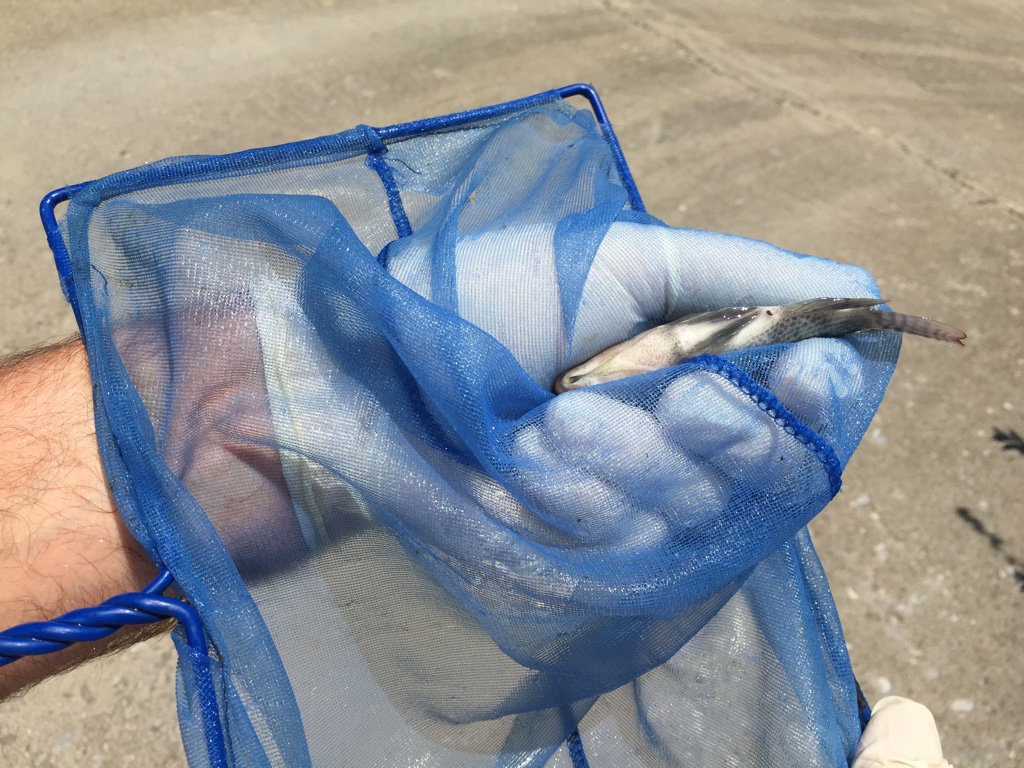
Step two
Dry the genital papilla using a paper towel and apply a small amount of high contrast stain.
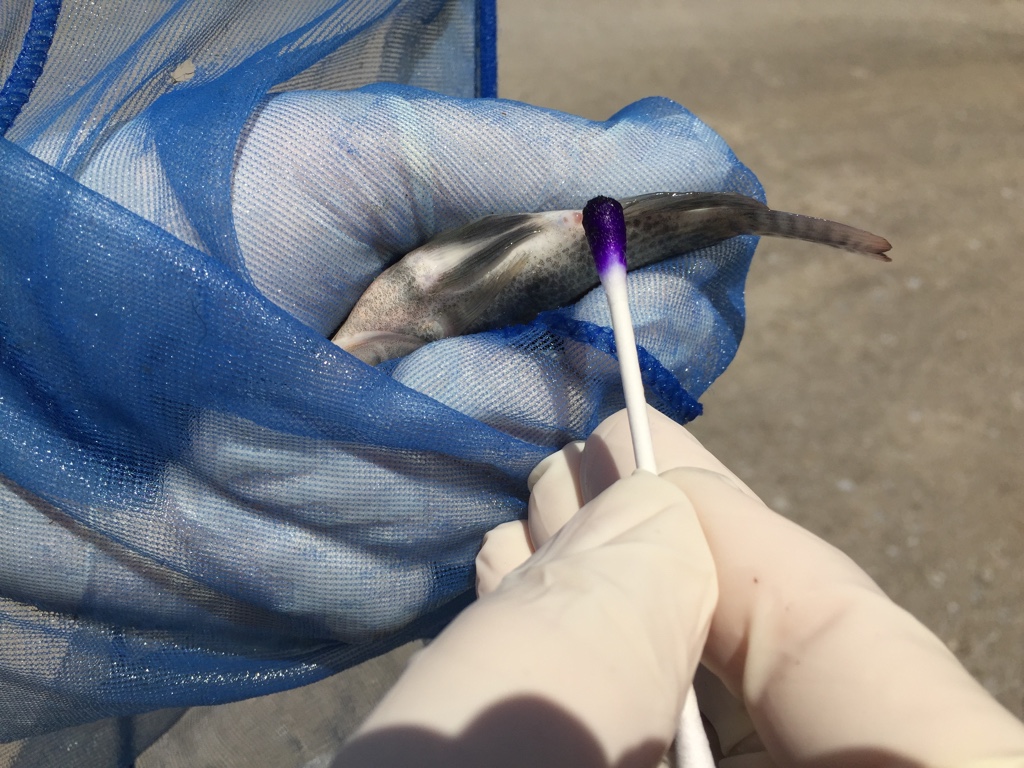
There is no need to apply stain to any areas other than what is shown in the picture below.
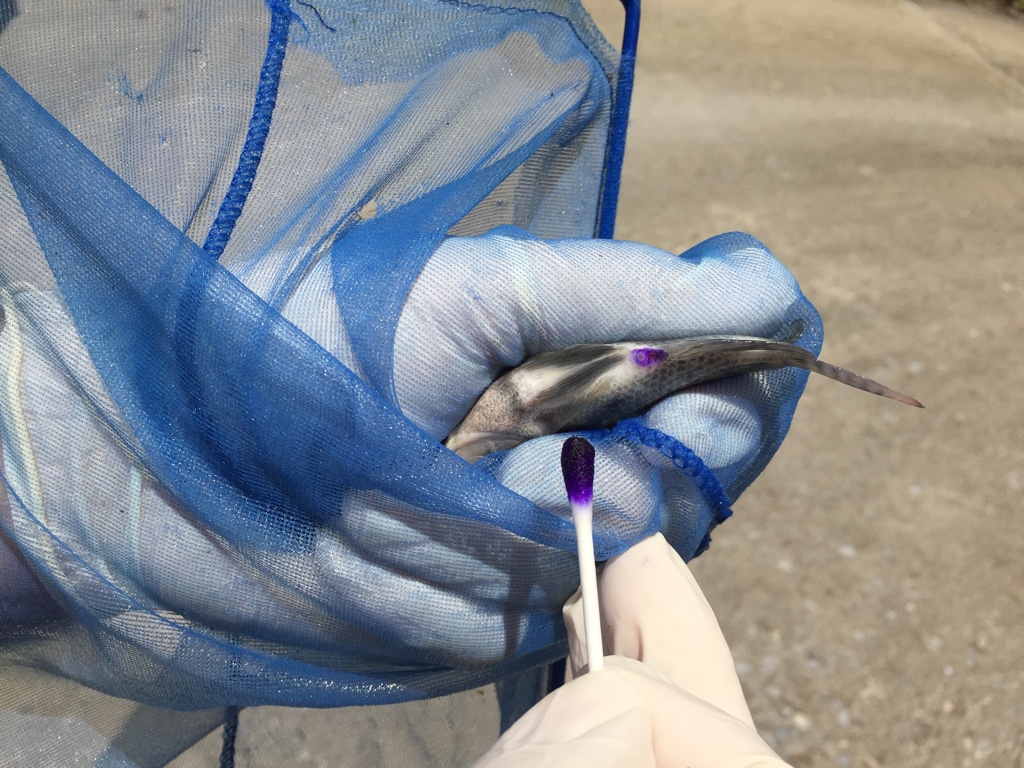
Step three
Put on your magnifying visor, if it isn't already on your head, and examine the stained area. Sometimes it helps a bit to turn your body to alter the angle of the sun and shadows. You might also give the sides of the fish near the genital region a very light squeeze to slightly increase the internal pressure in that area. The oviduct is very tiny and sometimes you can't see it, all you may see is an indentation in the papilla where the oviduct should be. If you don't see either of these, it's a male.
Well what do you know, it's a girl!
The pictures below were taken looking through my visor and attached monocle. Remember that you are looking at something that is about one square millimeter and almost impossible to photograph. Hoever, even in perfect focus, the oviduct was not visible in this instance.
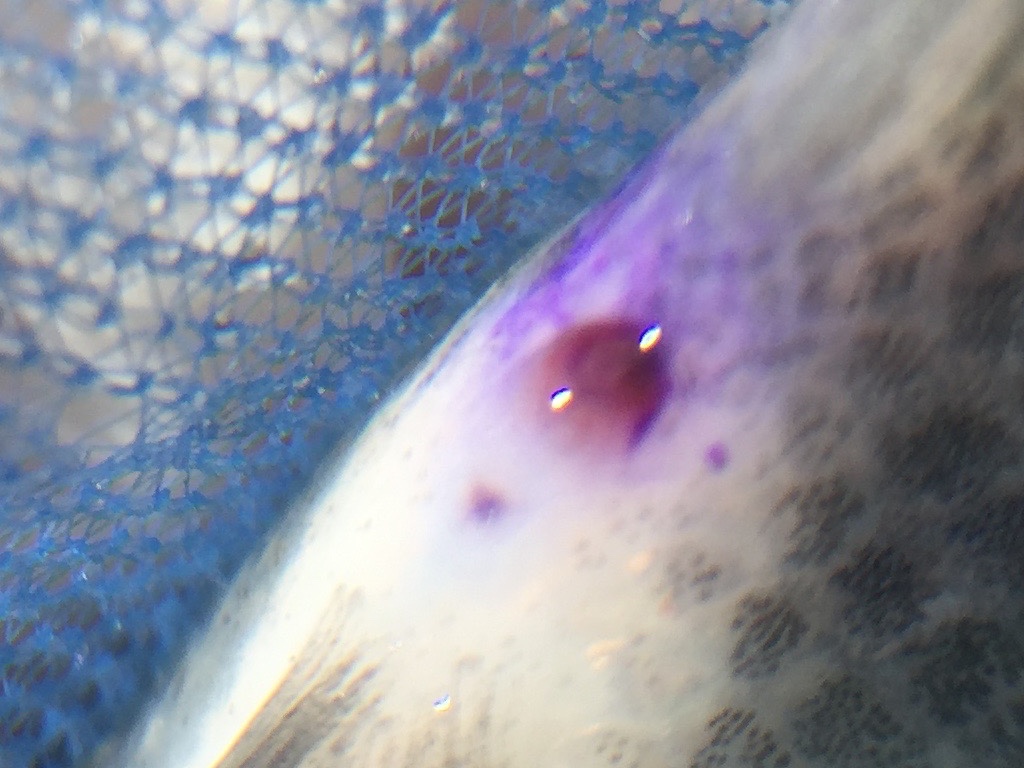
So how do I know that she's a female? Notice the two points of light on the papilla? That's how. Those two points of light indicate that there is an indent between them. If it was a male, the light would look much different.
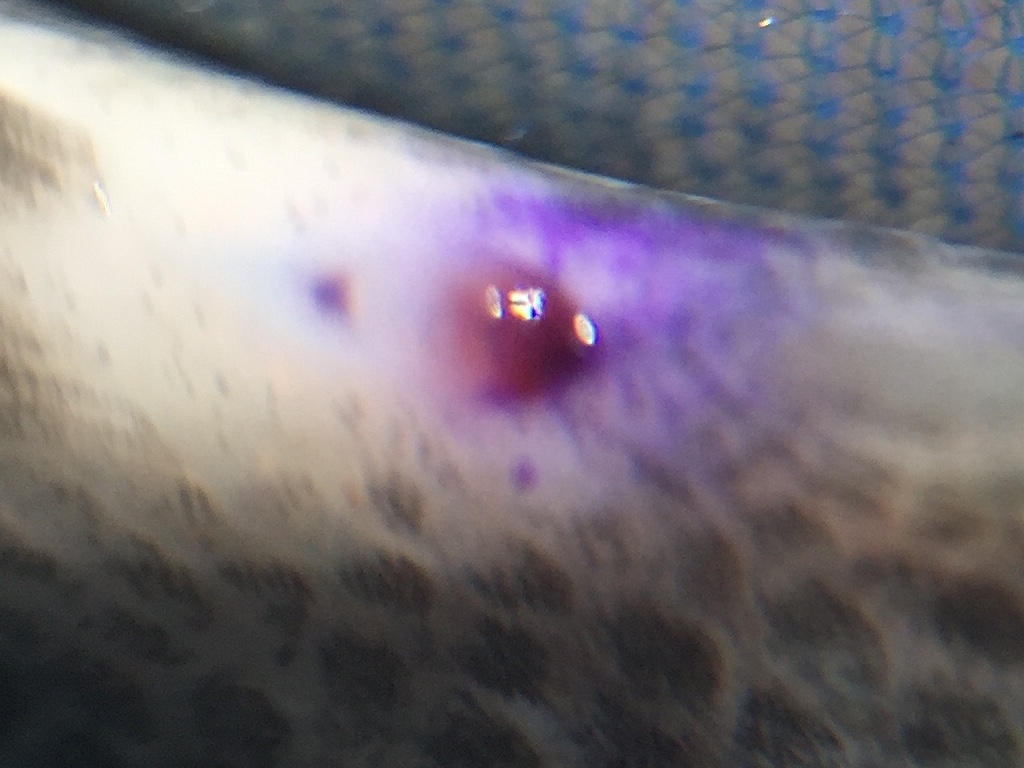
I debated whether or not to use the pictures above in this guide, but the more I think about it, the more it makes sense. Sexing tilapia takes practice, lots of practice. I have taught people who still ask me for a second opinion. I know that this is a girl the same way that you'd be able to identify a nude human male or females using lights and shadows.
Okay, so it wouldn't be fair to leave you like this, so here's a picture of the genital papilla of an eight inch breeding female that is still actively spawning. The oviduct is clearly visible without high contrast stain. See the tiny red line in the middle of the papilla? That's her oviduct. It's still less than a millimeter long but several times longer than the four inch breeding tilapia that I sexed for this page.

